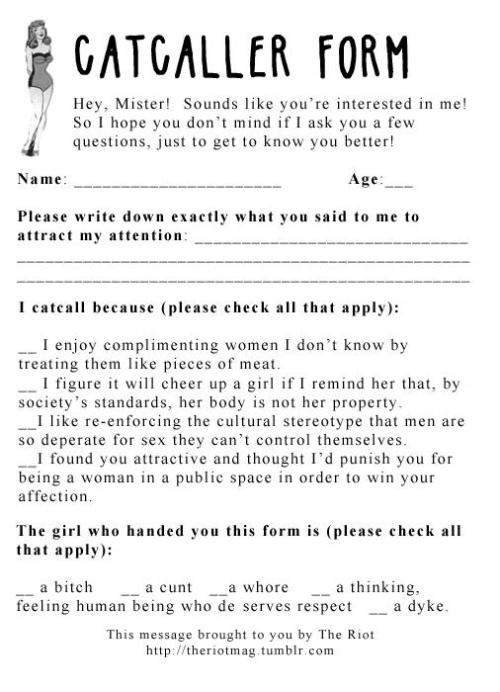Sometimes circumstances are such that assertive responses or reporting harassers can’t or hasn’t worked or don’t feel like comfortable options. That’s when it’s time to brainstorm what might work. Here are 5 non-traditional responses.
 1. Jessie shared this story and photo on the Hollaback website about how she dealt with harassers at a construction site.
1. Jessie shared this story and photo on the Hollaback website about how she dealt with harassers at a construction site.
“There was a construction site near my house for several months. I had been avoiding walking near it whenever possible, taking the longer route between my home and my bus stop. One day I had the *audacity* to just take the faster way home. I figured that if I just walked fast and pretended to be on the phone that I would be safe. Wrong. Several men, both on the ground and on the building, started to yell at me. A couple of them even approached the fence to get as close as possible, making vulgar gestures and remarks. When I got home I made this sign and posted it late at night. I used zip ties to secure it to their fence, facing the busy street in front of the construction site. They didn’t manage to get the sign down until 9am – long after all the rush hour traffic got to read my message. On the back of the sign, I included the definition of sexual harassment and a special message for the assholes that made me feel unsafe in my own neighbourhood.”
2. After surveying people about their pet-peeves on the subway system, artist jayshells created several posters, including this one about harassment. He hung 400 in stations all over NYC.
 3. In the late 1980s artist Ilona Granet design several anti-harassment street signs. Her goal was to “get the word out that women usually find street harassment unpleasant, annoying to grotesque, and intolerable.” One sign says, “Curb your animal instincts” in both English and Spanish and another says, “No Cat Calls, Whistling, Kissing Sounds.” They are made of the same type of material as a stop sign and are about the same size.
3. In the late 1980s artist Ilona Granet design several anti-harassment street signs. Her goal was to “get the word out that women usually find street harassment unpleasant, annoying to grotesque, and intolerable.” One sign says, “Curb your animal instincts” in both English and Spanish and another says, “No Cat Calls, Whistling, Kissing Sounds.” They are made of the same type of material as a stop sign and are about the same size.
Granet exhibited her signs at the Museum of Modern Art in New York and various traveling shows. Most impressively, she worked with the New York City Department of Transportation (DOT) to get several of her signs posted in public for about a year. She was able to do so successfully in locations near the World Trade Center, the Brooklyn Bridge, South Street Seaport, Borough of Manhattan Community College, and Battery Park. Her signs generated a huge amount of press across the world, including radio, television, newspapers, and magazines.
4. In 2010, Lisa Robinson, her husband, and their five-year-old son were on the train, returning home from a day trip to Cardiff (Wales) where they had celebrated the son’s birthday. There were about 30 drunk Cardiff football (soccer) fans on the train with them. The men were harassing a female passenger on a train platform. When Robinson told them to stop, they began yelling seixst and obscene comments at her.
 Robinson pulled the red handle to stop the train. She informed the conductor about the harassment and asked that he call the police. The conductor did nothing and started the train back up. Undeterred by the train conductor’s indifference, Robinson and her family got off the train at their stop and again asked that something be done about the rowdy men. The train conductor refused again. Robinson decided to do something more. She stood in the tracks! She would not move until the police were called. The transit police and local politicians all decried the behavior of the harassers and the conductor and applauded Robinson and the police opened an investigation.
Robinson pulled the red handle to stop the train. She informed the conductor about the harassment and asked that he call the police. The conductor did nothing and started the train back up. Undeterred by the train conductor’s indifference, Robinson and her family got off the train at their stop and again asked that something be done about the rowdy men. The train conductor refused again. Robinson decided to do something more. She stood in the tracks! She would not move until the police were called. The transit police and local politicians all decried the behavior of the harassers and the conductor and applauded Robinson and the police opened an investigation.
Robinson said, “This is my community, this is my village. We’re not going to be bullied and certainly for women and families, they should be able to travel on the train in peace and quiet and go about their business without being bullied like that.”
5. The folks at The Riot created this handy form, from “The Riot’s Great Big Patriarchy-Smashing Activity Book!”


